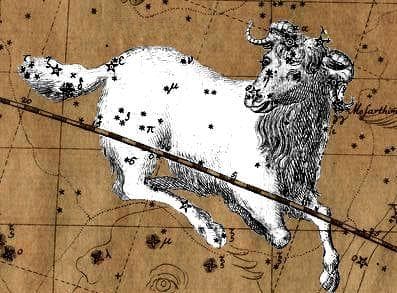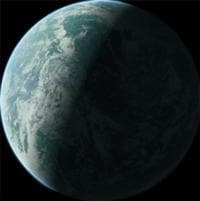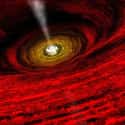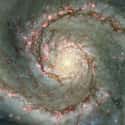(#1) A Black Hole Doesn't Collapse Everything - It Spits It Out At A Different Point In Spacetime
Black holes are inescapable regions in spacetime. For years, many believed anything sucked into a black hole by its strong gravitational pull would collapse, eventually folding into the black hole's singularity, or densest point.
While it is impossible to study what actually is in a black hole, Poplawski has an idea: what if our universe exists in a black hole inside of another universe?
Poplawski believes matter is carried via an Einstein-Rosen bridge, AKA a wormhole. According to Poplawski, the opening of a wormhole is a black hole, and on the other side is a "white hole." When the matter enters a black hole, it travels to a different time and space and is spit out through the white hole. The matter then expands to form another universe.

(#2) Poplawski's Theory Limits Singularity As We Currently Know It
Some scientists believe the universe was formed from a speck of matter so small, dense, and finite, that it is beyond anything our minds can imagine. Many of them had accepted the idea of a singularity, or "god particle," as the origin of the universe, but had constantly struggled to defend and prove its existence. Poplawski's theory eliminates that idea.
Poplawski believes these points DO have a limit as to how small they can be compressed and how much they can weigh. In Poplawski's theory, there is no god particle or singularity. Like a snake nut can, anything that is tightly compressed reaches its limit; then there's a "bang" - maybe the very one that started our universe.
(#3) The Theory Suggests The Big Bang Started With A Black Hole
Before the Big Bang (or the Big Bounce, according to some physicists) there was said to be nothing. But how can everything come from nothing? According to Poplawski, it can't, which makes his theory even more plausible.
Poplawski theorizes this god particle - or the beginnings of our universe, no matter how big or small - came from matter from another universe sucked into a black hole. This matter traveled through the black hole and exploded into the beginnings of our universe when it came out the other side of spacetime.

(#4) An Amended Version Of Einstein's General Theory Of Relativity Supports The Idea
Einstein's general relativity describes any and all events in the universe as occurring at one specific point in space and time. Theoretical physicists have long been grappling with combining the theory of relativity, which describes the universe on a larger scale, with quantum mechanics, a theory that examines the universe at its smallest levels, like the atom. By combining the two theories, theoretical physicists would be able to study "quantum gravity," which would help illuminate the mysteries behind certain phenomena, including what happens to matter once it enters a black hole.
While the original theory of general relativity does not support Poplawski's idea, an adaptation of Einstein's theory which takes into account the effects of quantum mechanics does. This adaptation, called the Einstein-Cartan-Sciama-Kibble theory of gravity, takes the important quantum property known as "spin" into account.
Atoms and electrons spin with "an internal angular momentum that is analogous to a skater spinning on ice," according to Poplawski.
(#5) The Quantum Mechanics Idea Of Torsion Explains How A Black Hole Could Spit Out A Universe
When particles spin and interact with spacetime, it creates another property - torsion, or twisting. Poplawski believes torsion is notable only "in extreme environments" - such as those seen in a black hole. So what exactly is torsion? Poplawski likens it to a thin, twisted rod.
If the rod is spacetime, bending it would create curvature (like the gravity of massive objects like the sun), and twisting it would create torsion. Eventually, the rod (spacetime) would be twisted so tightly it would snap out of its twist; the gravity holding the twist in place would no longer be able to resist the strength of the torsion. This would create a "big bounce," flinging the energy from torsion that was converted to matter into a new, baby universe.
"The increasing numbers of particles with spin would result in higher levels of spacetime torsion. The repulsive torsion would stop the collapse and would create a 'big bounce' like a compressed beach ball that snaps outward. The rapid recoil after such a big bounce could be what has led to our expanding universe. The result of this recoil matches observations of the universe's shape, geometry, and distribution of mass."

(#6) Poplawski Calculates That Matter Expands At A Rate Of 1.4 Times Its Size In Less Than 30 Seconds In A Black Hole
According to Poplawski, the numbers have it. His calculations prove beyond the shadow of a doubt that torsion plays a part in the Big Bang. As matter reaches peak density in a black hole, torsion runs contrary to gravity which prevents it from compressing infinitely to a singularity, as Einstein believed.
Instead, matter "bounces" and starts to expand. Poplawski's calculations show that matter expands 1.4 times its size in less than half a minute, which is how he believes the our universe came to be.

(#7) The Rotation Of Black Holes Feed Into Poplawski's Theory
One way to know for sure if Poplawski's theory works is to look at the rotation of a black hole and its corresponding universe. If a universe was created inside a hole, the universe in question should rotate in a similar fashion as the black hole itself.
While measuring a black hole's rotation precisely is not something we can do just yet, if future findings prove correct, it could lend credence to Poplawski's wormhole theory - that black holes are just passageways from one reality to another.

(#8) There Are Maybe Other Universes Out There That Got Their Start The Same Way
If our universe exists in a black hole, it could be just as easily argued that other universes exist inside their own black holes as well.
However, while Poplawski's theory explains the Big Bang and the origins of our universe pretty succinctly, it doesn't reveal much about the parent universe. Where did it originate?Has it always existed, or did it form just like our universe? In short, how many nesting dolls are there with these black hole universes?
University of California Davis physicist Andreas Albrecht says there won't be an answer anytime soon. "There're really some pressing problems we're trying to solve, and it's not clear that any of this is offering a way forward with that," he told National Geographic.
(#9) Popławski Could Be 'The Next Einstein'
Popławski is no slouch in the world of science. He is one of nine people to be named Forbes's Next Einstein for his research into the theory our universe was created in a black hole, which he introduced to the world in 2010. That year, both National Geographic and Science magazines heralded the theory as one of the top discoveries of that year.
Popławski has also made TV appearances on various Discovery Channel shows as one the preeminent on black holes and parallel universes. While his theory seems far-fetched, to some respected scientists say it shouldn't be ruled out. Physicist Andreas Albrecht says while the theory may be strange, it may also be plausible. "Everything people ask in this business is pretty weird. You can't say the less weird [idea] is going to win, because that's not the way it's been, by any means."
(#10) There Are Other Theories Explaining The Chaos Of Our Universe
Our grasp of the universe - while growing - is still no bigger than the alleged god particle. Theoretical physicists, cosmologists, and astronomers have been grappling with the mysteries of the universe since the dawn of time. Some of these members of the scientific community have come up with some pretty convincing (and sometimes horrifying) theories explaining various phenomena in our universe.
If existential curiosity is your thing, be sure to check out this list on theories about the universe that will keep you up at night.
New Random Displays Display All By Ranking
About This Tool
In 1916, the German astronomer Karl Schwarzschild calculated a vacuum solution for the Einstein Field Equations, which showed that if the actual radius of static spherically symmetric star was less than a fixed value, strange phenomena would occur around it, that is, there is an interface -- a “horizon”, into which light can not escape. This value is called the Schwarzschild radius, an “incredible object” named by American physicists John Archibald Wheeler as a “black hole”.
This random generator tool generates 10 entries, introducing 10 theoretical ideas about black holes and the cosmological view, which is very informative and scientifically informed. If you’re a cosmologist or you’re interested in astronomy, you can refer to it.
Our data comes from Ranker, If you want to participate in the ranking of items displayed on this page, please click here.















